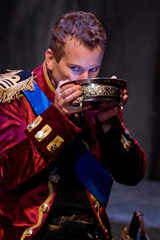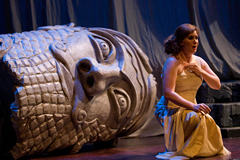| Opera Reviews | 25 April 2024 |
| Pinchgut
triumphant by Sandra Bowdler |
|
| Vivaldi: Juditha Triumphans Pinchgut Opera City Recital Hall, Sydney 5 December 2007 |
|
|
Juditha Triumphans is in fact an oratorio, not written to be staged, and not even to be seen, as the young women for whom it was written in a Venetian charitable school remained cloistered during their performances. Vivaldi's operas as such remain something of an unknown entity as far as their stageable qualities go, but, on the evidence of this production, should provide exciting dramatic possibilities. The lurid biblical story of Judith (Old Testament for those of Catholic or Orthodox persuasion, Apocrypha for Protestants), a respectable widow who cut off the head of an enemy of her people, has long attracted media attention. It has been the subject of many works of visual art down the centuries - Caravaggio, Gentilleschi, Botticelli, Titian, to name but a few - as well as musical depictions by such 18th century composers as Scarlatti and Almeida, not to mention a more recent version by Eugene Goossens. There even appear to be two popular music acts of that name, an individual named Judith Holofernes and a group named Judith and Holofernes (although I may of course have that wrong). In any case, the original narrative has the Jewish Judith with her loyal sidekick, another widow named Abra, fronting up to the tent of the Assyrian general Holofernes who is besieging their town Bethulia, and causing him to lose his head, first figuratively, then literally. The other figures in the original story are Holofernes' eunuch Vagao (here Latinised to Vagaus) and Ozias, the ruler of Bethulia. Vivaldi set all five personae as high voice parts, given that he was writing for an all-girl cast. Director Mark Gaal has taken a rather literalist slant, casting indubitably male American countertenor David Walker as Holofernes, retaining women in all the other parts but depicting them as women, so the eunuch becomes a female aide-de-camp with more than a professional interest in her master, and Ozias becomes a priestess rather than a priest or king. This probably makes it all a bit easier for a modern audience confused by eighteenth century gender-blind or gender-confused casting, although you'd think everyone would have got that message by now. City Recital Hall, Pinchgut's performance home, is, as the name suggests, not a proper opera theatre, lacking a pit, proscenium stage, fly tower, wings and so on. The orchestra usually locates itself in front of the stage at the same level as the audience, and so it does here. On the stage itself a large three-storeyed scaffold has been constructed, with moveable gauze curtains, thus allowing the action to flow vertically and adding another dimension to the performance space. A large Assyrian head lying on its side dominates the scene from high up the scaffold in Part One, being relocated to the lowest level for Part Two, with the obvious implication. Costumes and set make no attempt at any form of historicity, being a
melange of styles from 18th to 21st centuries. The women wear long flowing
gowns, Holofernes wears modern-looking combat fatigues and a more formal
be-medalled tunic for his big night in with Judith, and the chorus appear
variously as a cohort of modern guerilla fighters in balaclavas, variously
dressed victims of war and oppression, and whited out figures of the dead.
Vagaus is kitted out in a smart military outfit in part one, but reappears
in a slinky evening skirt and bare shouldered top to assist Holofernes
with Judith's seduction. She also has to hobble around on a crutch, rather
distracting but useful for flailing out at people (a la Margaret Mead).
There is some rather otiose sub-Sellars hand-gesturing, but generally
the stage business is kept to an unfussy hewing to the narrative line.
There was an occasional stilted moment in Part One on the first night,
but this will surely become more fluid on subsequent performances. |
|
|
Pinchgut performances are always a rare musical feast for the baroque aficionado, and this time, despite lacking their usual conductor Anthony Walker (busy in Melbourne with Opera Australia's Alcina in Melbourne, but in the audience for Juditha's opening night), the Orchestra of the Antipodes scaled new heights. Conducted from the harpsichord by Attilio Cremonesi with passion and precision, the orchestra this year featured a range of exotic period instruments: a chalumeau, two custom-made baroque clarinets, a viola d'amore and a baroque mandolin. Along with three theorboes and an archlute, this produced some wondrous soundscapes through the performance. Sally-Anne Russell in the lead role not only sang with impassioned richness of tone but also produced a believable character, steadfast and implacable, but wrought with regret for the violence she perpetrates. She makes some remarkable ethereal sounds with the viola d'amore in 'Quanto magis generosa', and sings seductively with the mandolino and plucked violins in 'Transit aetas, volant anni'. The clear penetrating voice of David Walker is remarkably even across its range for a countertenor, with sustained low notes and flexible on the runs. While there is not a great deal of vocal embellishment on anyone's part, Walker does manage an excellent cadenza in 'Sede, o cara'. Holofernes' ruthlessness is established early on when he casually cuts the throat of one of the captives, and in the scenes with Judith, Walker convincingly sets up a palpable sense of sexual tension. The biblically sexless Vagaus is here transformed into a caring female companion, carrying out all her master's whims and devastated by his death. Fiona Campbell is singing at her very best in this role, with ringing golden high notes and warmth and resonance in the lower range. Her final aria 'Armatae face et anguibus' was movingly beautiful, and deservedly well-received by the audience. While the four main singers have each lost an aria, Abra also has her final da capo truncated to allow for a rapid and dramatic dash with Judith from the death scene. This is a pity, as soprano Sara Macliver is always a joy to hear and sings with exquisite accuracy and purity, but does not really get to show off her baroque vocal chops. Dramatically, the interactions between Abra and Judith are moving and convincing, particularly their pact before the end of Part One, where they clasp hands and lean in and touch their heads together. Mezzo Renae Martin makes a strong showing in her two arias as Ozias. It seems almost unnecessary to say that the singing of the choir Cantillation was, as ever, precise and gorgeous. This production shows what can be achieved by a small outfit with limited resouces in a big city with a dominating national company: all you need is a troupe of the best singers available, brilliant instrumentalists and a world class choir, not to mention a dedicated and talented production team. Pinchgut triumphant indeed. |
|
| Text ©
Sandra Bowdler Photos © Simon Hodgson (top), Sarah Puttock (bottom) |

 To
say that this year's offering from Sydney's Pinchgut Opera is up to their
usual standard is say it is of the highest musical quality Australia can
offer. Their latest production is definitely in that league, and in some
respects surpasses their previous efforts, with uniformly strong singing
and acting, a clearly focussed narrative and highly effective set.
To
say that this year's offering from Sydney's Pinchgut Opera is up to their
usual standard is say it is of the highest musical quality Australia can
offer. Their latest production is definitely in that league, and in some
respects surpasses their previous efforts, with uniformly strong singing
and acting, a clearly focussed narrative and highly effective set.  Various
reminders of the relevance of the story to contemporary events are included,
although they are hardly necessary. In one rather laboured episode, Judith
is fitted out with a suicide bomb under what must surely be a rather cumbersome
outer garment, and in the final chorus of Part One (of two parts), Abra
seems to be comparing the efficacy of suicide bomb vs knife. In case we
didn't quite get the contemporary parallels, the words "to exist" "is
to resist" adorn either side of the stage. Other props are rather more
effective, such as a cage full of white doves representing peace, and
Holofernes' helmet (of no particular authenticity) representing his head.
The actual decapitation scene is an excellent coup de theatre, as Judith
swings the heavy sword around as the lights flash, and emerges into the
light with splashes of blood over her costume.
Various
reminders of the relevance of the story to contemporary events are included,
although they are hardly necessary. In one rather laboured episode, Judith
is fitted out with a suicide bomb under what must surely be a rather cumbersome
outer garment, and in the final chorus of Part One (of two parts), Abra
seems to be comparing the efficacy of suicide bomb vs knife. In case we
didn't quite get the contemporary parallels, the words "to exist" "is
to resist" adorn either side of the stage. Other props are rather more
effective, such as a cage full of white doves representing peace, and
Holofernes' helmet (of no particular authenticity) representing his head.
The actual decapitation scene is an excellent coup de theatre, as Judith
swings the heavy sword around as the lights flash, and emerges into the
light with splashes of blood over her costume. 





